Genesis of the Maoping carbonate-hosted Pb-Zn deposit,northeastern Yunnan Province, China: evidences from geology and C-O-S-Pb isotopes
2020-11-10YufanHeTaoWuZhilongHuangLinYePingDengZhenzhongXiang
Yufan He · Tao Wu· Zhilong Huang · Lin Ye · Ping Deng ·Zhenzhong Xiang
Abstract The Maoping Pb-Zn deposit (~ 3 Mt Pb + Zn reserves with grades of 12-30 wt%) is one of the largest Pb-Zn deposits in the Sichuan-Yunnan-Guizhou (SYG)metallogenic province,which has contributed a tremendous amount of lead and zinc resources for China. To obtain a further understanding of the sources of ore-forming materials and ore genesis of the deposit, S-Pb isotopes of sulfides and C-O isotopes of ore-stage calcites were systematically collected from representative orebodies at different elevations with a Finnigan MAT-253 mass spectrometer.The calcites separated from the sulfides of the No I and No II orebodies shared identical δ13CPDB values(- 5.3 to - 0.8 ‰) and δ18OSMOW values (+ 14.5 to+ 21.8 ‰) with those of the calcites in the SYG region,suggesting that CO2 in regional ore-forming fluids possibly had a homologous C-O source that originated from a ternary mixture of the dissolution of marine carbonate rocks, degassing process of the Emeishan mantle plume,and dehydroxylation of sedimentary organic matter. The No.I-1 and No.I-2 orebody was hosted in the same strata,but the sulfur source of No.I-1 orebody(+ 13.1 to+ 19.0‰) with equilibrated sulfur fractionation (δ34Ssphalerite-<δ34Sgalena) and No. I-2 orebody (+ 18.0 to + 21.8 ‰)with sulfur equilibrium fractionation (δ34Ssphalerite > δ34-Sgalena) were different. They were derived from the allopatry thermochemical sulfate reduction (TSR) of overlying Carboniferous sulfates in the ore-hosting strata and local TSR of sulfates in the ore-bearing Upper Devonian Zaige Formation, respectively. The narrow and uniform Pb isotopic ratios of single galena grains collected from sulfides with 206Pb/204Pb of 18.713-18.759,207Pb/204Pb of 15.772-15.776 and 208Pb/204Pb of 39.383-39.467 indicate a well-mixed metal source(s) that consist of Proterozoic Kunyang and Huili Group basement rocks and Devonian to Middle Permian ore-hosting sedimentary rocks.Besides, the late Permian Emeishan basalts are difficult to contribute metals for regional Pb-Zn mineralization despite a closely spatial relationship with the distribution of the Pb-Zn deposit. This is supported by Pb isotopic ratios plotting above the average upper crustal Pb evolution curves and staying far away from that of the agecorrected Emeishan basalts. Hence, taking into account of the similarities in tectonic setting, ore-hosting rock, ore assemblage, wall rock alteration, ore-controlling structure,and ore-forming materials and the differences in relationship with regional magmatism, fluid inclusion characteristic and ore grade between the Maoping deposit and typical MVT Pb-Zn deposit, the ore genesis of the Maoping deposit should be an MVT like Pb-Zn deposit.
Keywords Maoping Pb-Zn deposit · Ore-forming materials · Ore genesis · MVT-like deposit
1 Introduction
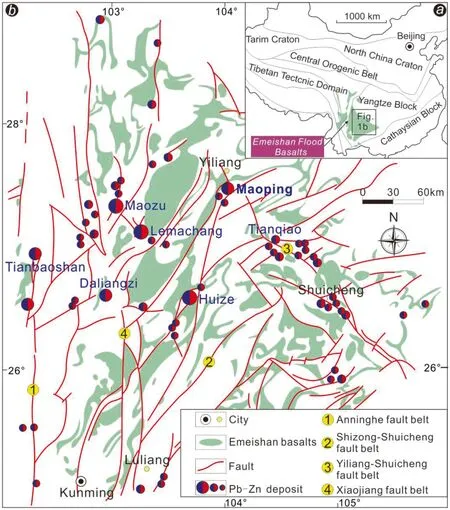
Fig. 1 Geological sketch map of the Sichuan-Yunnan-Guizhou(SYG)Pb-Zn metallogenic province,showing the Geotectonic location(a)and the distribution of faults, Emeishan flood basalts and Pb-Zn deposits (b, modified after Liu and Lin 1999)
The Sichuan-Yunnan-Guizhou (SYG) Pb-Zn metallogenic province, including the southern Sichuan, northeastern Yunnan and northeastern Guizhou ore districts, is located in the southwestern Yangtze block(Fig. 1a;Huang et al.2004;Zhang et al.2005),which is a significant part of the giant South China low-temperature metallogenic domain (SCLTMD)and also an important production base of lead, zinc, germanium, and silver in China (Hu et al.2016, 2017a, b; Zhou et al. 2018). Several world-class to large-scale Pb-Zn deposits occur in the northeastern Yunnan district under a similar metallogenic setting, such as Huize, Lemachang, Maoping, Fule, Maozu, and Jinshachang, etc. (Fig. 1b; Ye et al. 2011; Han et al. 2012;Zhou et al. 2013a, 2018). These deposits are characterized by (1) being hosted in the carbonate rocks of the late Ediacaran to middle Permian strata (Zhou et al. 2018); (2)being controlled by multi-stage faults and spatially relevant to the late Permian Emeishan basalts (Fig. 1b; Han et al.2012; Wang et al. 2017); (3) having stratiform, lenticular and scrotiform sulfide orebodies with significant epigenetic features occurred in the fold bedding-planes or steep sulfide veins displayed along fault dip planes (Zheng and Wang 1991; Li et al. 2015; Wei et al. 2015); (4) having low-moderate temperature (120-280 °C) and medium-high salinity (10-22 wt% NaCl equiv.) of the fluid inclusions (Zhang et al. 2015; Liu et al. 2017); and (5) having high ore grades with 10-35 wt% Pb + Zn and associated with Ge,Ag,Cd and Ga,etc.(Zhou et al.2014a;Zhu et al.2017).
The Maoping deposit is the second largest Pb-Zn deposit in the SYG region with more than three million tons(Mt)of lead and zinc reserves(Tan et al.2019),which is just second to the world-class Huize deposit (>5 Mt Pb + Zn reserves; Huang et al. 2004). During the past decades, great progresses have been made in geological features (Wei et al. 2015; Wang et al. 2017), fluid inclusions (Han et al. 2007; Wang et al. 2009; Cui and Han 2014), associated elements (Qiu et al. 2013; Chen et al.2016), sphalerite Rb-Sr dating (Shen et al. 2016; Yang et al. 2019), and S-Pb isotopic studies (Ren et al. 2018;Tan et al. 2019; Xiang et al. 2020) in Maoping deposit.However, the Maoping deposit had received a little attention of research, especially on the metallogenic age,source(s) of ore-forming materials, and relationship between Emeishan basaltic magmatism and regional Pb-Zn mineralization. Several aspects of the ore genesis are still under debate.For example,Shen et al.(2016)obtained a sphalerite Rb-Sr isochron age of 321.7 ± 5.8 Ma, while a younger sphalerite Rb-Sr isochron age of 202.5 ± 8.5 Ma was reported by Yang et al. (2019). Furthermore,according to the research of C-H-O isotopes,the ore-forming fluids were mainly derived from magma and hosted formation waters with a certain contribution from metamorphic water (Zou et al. 2004; Han et al. 2007).However, based on the analyses of S-Pb isotopes, the oreforming metals were mainly originated from ore-bearing rocks with the addition of some basements and basalt components(Tan et al.2019;Xiang et al.2020).Besides,it is still disputable on whether most epigenetic Pb-Zn deposits in the SYG region,including the Maoping deposit,can be classified as the Mississippi Valley-type(MVT)Pb-Zn deposit (Han et al. 2007; Zhang et al. 2019a, b; Luo et al. 2020).
Previous studies have proven that C-O-S-Pb isotopic analyses are powerful means to determine the source(s) of ore-forming fluid and constrain the origin of the ore deposit(Li et al. 2015; Zhou et al. 2013a; Tan et al. 2017; Wang et al. 2018; Luo et al. 2020). In this study, based on the detailed ore deposit characteristics, systematic C-O isotopes of ore-stage calcites from No. I and II orebodies and comprehensive S-Pb isotopes of sulfides in No. I orebody(group) from bottom to top with exact elevations are collectively investigated to trace the carbon, oxygen, sulfur,and metal source(s) and discuss the ore genesis of the Maoping Pb-Zn deposit.The outcomes will provide further understanding of the formation of the SYG Pb-Zn metallogenic province and similar deposits in the SCLTMD.
2 Geological setting
The SYG Pb-Zn metallogenic province is situated in a triangle area enclosed by NS-trending Anninghe fault,NE-trending Shizong-Mile fault and NW-trending Yiliang-Shuicheng fault (Fig. 1b; Ren et al. 2018). The regional stratigraphy is mainly composed of Archean to Paleoproterozoic crystalline basements, Meso- to Neoproterozoic folded basements, and cover sequences that consist of Paleozoic to Early Mesozoic marine sedimentary rocks,Late Permian Emeishan continental flood basalt and Late Mesozoic to Cenozoic continental sedimentary rocks (Tan et al.2019;Zhang et al.2019a,b).Folds and faults widely occurred in the SYG region due to multi-stage tectonic movements including Caledonian, Hercynian, Indosinian and Yanshanian periods (Liu and Lin 1999). At about 260 Ma, large-scale mantle-plume-related magmatic activities took place, which formed widely distributed Emeishan basalts covering an area of over 250,000 km2(Fig. 1b; Zhou et al. 2002). Almost all Pb-Zn deposits of the SYG area are spatially located in the Emeishan Large Igneous Province (ELIP) (Fig. 1b; Liu and Lin 1999; Cui and Han 2014; Huang et al. 2004, 2010).
The Maoping Pb-Zn deposit is located in the northeastern SYG in Zhaotong City, Yunnan province, South China (Fig. 1a, b). Within the ore district, exposed strata mainly include the Silurian to Triassic marine sedimentary rocks (Fig. 2). Among which, the dolostone and limestone of the Upper Devonian Zaige Formation (D3zg), Lower Carboniferous Baizuo Formation (C1b), and Middle Carboniferous Weining Formation (C2w) are the most significant ore-hosting rocks (Fig. 3, Xiang et al. 2020). The NW-trending fault group including Fangmaba, Maoping,and Tuogumei faults collectively controlled the distribution of the Pb-Zn deposits in the region. Most orebodies,occurring as a ladder shape on the profile (Fig. 3), have a clear boundary with carbonate wall rocks (Fig. 4b). These stratoid, lenticular and veined orebodies (No.I, II, and III)of the Maoping deposit,yielding more than 3 Mt Pb + Zn resources at grades of 12-30 wt% (Ren et al. 2018), are hosted in the interlayer fracture zone in the steeply inclined strata of the Maomaoshan anticline (Figs. 3, 4a-c) and structurally controlled by NE-trending Maoping fault(Fig. 2;Liu and Lin 1999). The No. I orebody(group) can be further divided into No. I-1 and I-2 orebody, hosted in the dolostone and limestone of the Upper Devonian Zaige Formation, which is the largest orebody with the most abundant Pb-Zn resources grading at 20-45 wt%Pb + Zn in the Maoping deposit.
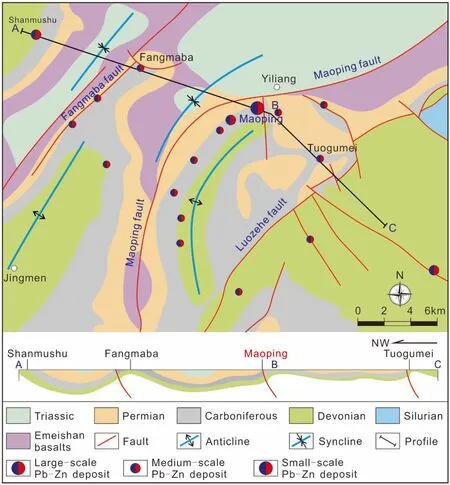
Fig. 2 Geological sketch map of the Maoping Pb-Zn deposit, displaying the A-B-C profile and the distribution of the strata, faults, and surrounding Pb-Zn deposits. Modified after Liu and Lin (1999)
Ore types of the Maoping deposit can be divided into sulfide and oxidized ores, which were formed in the hydrothermal and supergene ore-stage, respectively. Ore minerals of sulfides include sphalerite, galena, pyrite and minor chalcopyrite(Fig. 4d-f).The major gangue minerals are dolomite (Fig. 4b), calcite (Fig. 4f), and minor quartz.Sulfides ores are characterized by massive(Fig. 4d),veined(Fig. 4e) and dense disseminated (Fig. 4f) structures, and occurring as subhedral to anhedral granular (Fig. 4h, i),metasomatic (Fig. 4f), enclosed (Fig. 4h), coplanar(Fig. 4g) and interstitial (Fig. 4i) textures. Wall rock alterations including dolomitization, calcitization, silicification, and baritization are common in the Maoping deposit (Xiang et al. 2020). Among which, the dolomitization and silicification are closely related to the Pb-Zn deposits, generally considered as a great pathfinder in exploration for Pb-Zn deposit in the ore district(Wei et al.2012, 2014, 2015).
3 Sampling and analytical methods
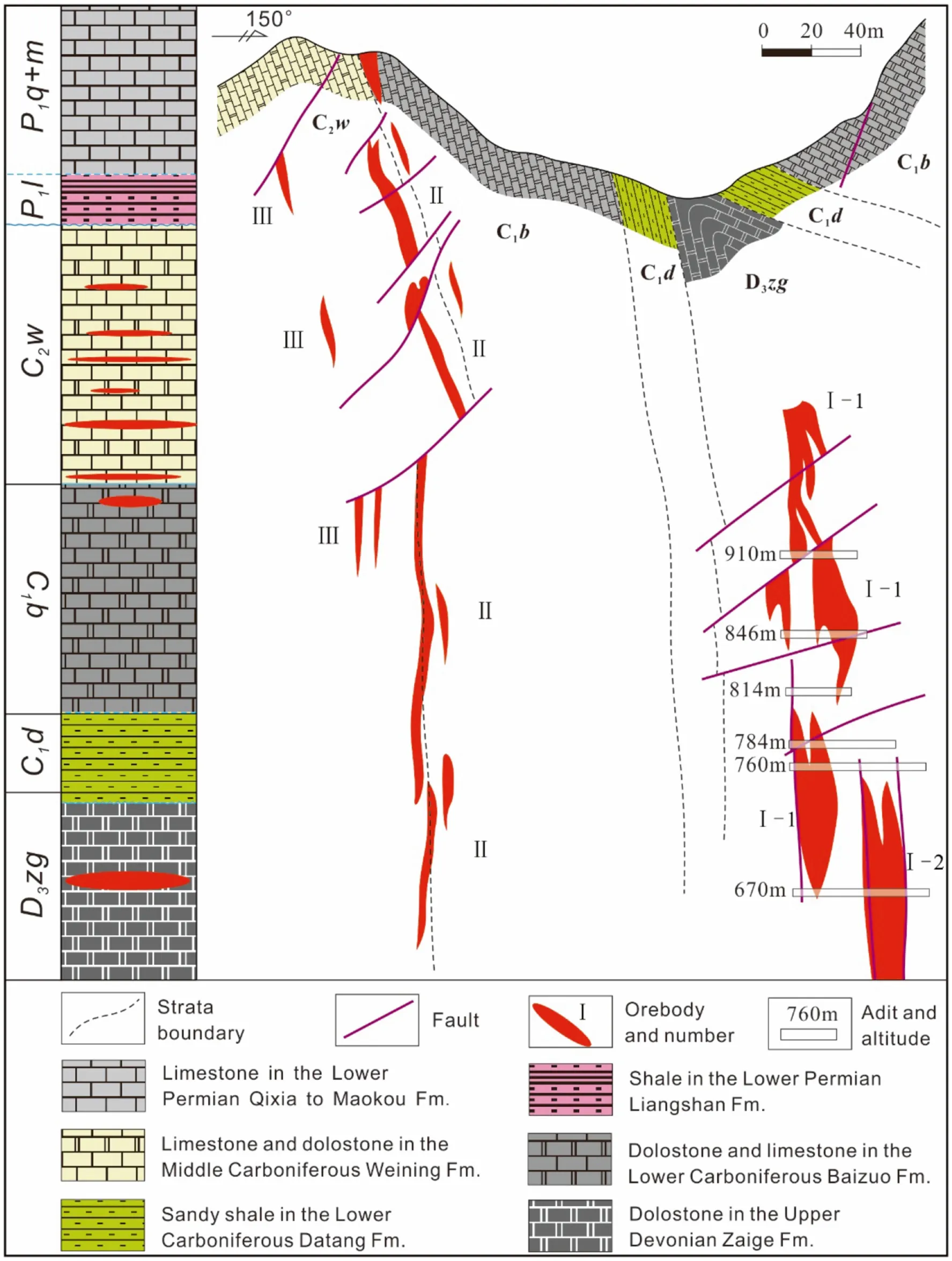
Fig. 3 The comprehensive profile map of the Maoping Pb-Zn deposit, exhibiting the distribution of the orebodies, ore-bearing strata and orecontrolling fault. Modified after Liu and Lin (1999)
More than ninety representative sulfide ore samples in the Maoping Pb-Zn deposit were collected from the 810, 760,and 720 m adits of the No. I-1 orebody, 720, 670, and 640 m adits of the No.I-2 orebody,760,and 703 m adits of the No. II orebody. Twenty-nine typical samples were crushed into 20 to 60 mesh, and ten ore-stage calcites(seven from No. I and three from No. II orebody)for C-O isotopic analyses, twenty-four sphalerites (thirteen from No. I-1 and eleven from No. I-2 orebody) for S isotopic analysis and fourteen galena samples (eight from No. I-1 and six from No. I-2 orebody) for S-Pb isotopic analyses were hand-picked under a binocular microscope.
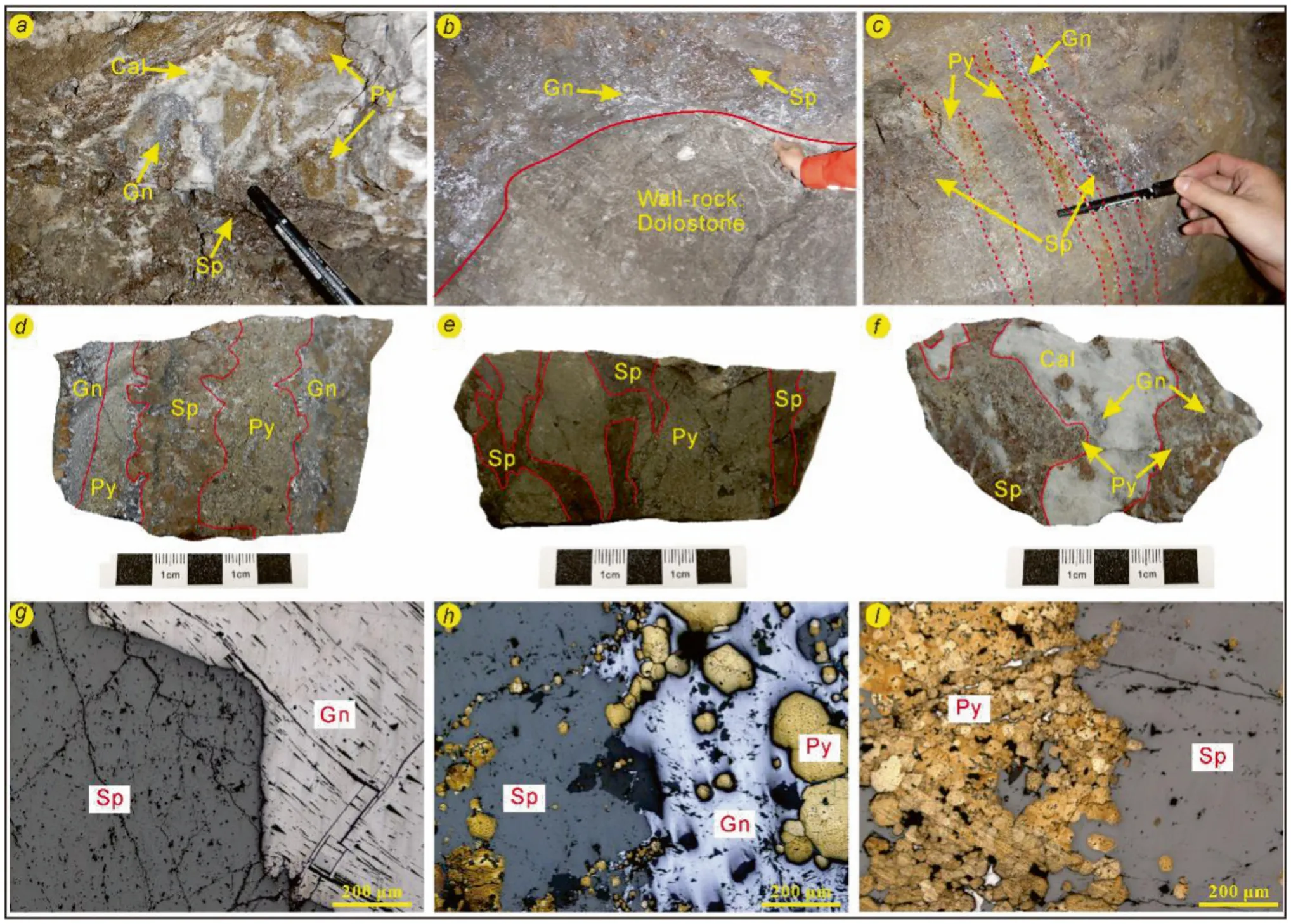
Fig. 4 Photos of the orebodies(a-c),sulfide samples(d-f)and microscopic characteristic(g-i).a sulfide minerals(pyrite,sphalerite and galena)replaced and enclosed by calcite;b A clear boundary between sphalerite-galena ores and wall rocks(dolostone);c Veined pyrite,sphalerite,and galena;d Massive sulfide ore including pyrite,sphalerite and galena;e Pyrite crosscut and replaced by sphalerite;f Dense disseminated sphalerite and galena replaced by calcite; g The coexisted sphalerite and galena; h pyrite enclosed by sphalerite and galena; i The coexisted subhedral sphalerite and pyrite. Abbreviations: Py-pyrite; Sp-sphalerite; Gn-galena; Cal-calcite
The carbon and oxygen isotopic compositions of the orestage calcites were performed at the State Key Laboratory of Ore Deposit Geochemistry (SKLODG), Institute of Geochemistry, Chinese Academy of Sciences (IGCAS), determined by a Finnigan MAT-253 mass spectrometer. The analytical precisions(2σ)of δ13C and δ18O values were ± 0.2 and ± 0.4 ‰, respectively. The Vienna Pee Dee Belemnite(V-PDB) was considered as standard. δ18OSMOW-= 1.03086 × δ18OPDB+ 30.86(Friedman and O’Neil 1977).
The sulfur isotopic analysis of the sphalerites and galena was carried out in the SKLODG of the IGCAS, by using the MAT-253 mass spectrometer. The Vienna Canyon Diablo Troilite(V-CDT)was used as a reference standard.IAEA S-1 (- 0.2 ‰), IAEA S-2 (+ 22.6 ‰), and IAEA S-3 (- 32.5 ‰) were regarded as an external standard to correct the isotopic values. The analytical precisions (2σ)of δ34S values were ± 0.2 ‰.
The lead isotopic analysis of single galena grain was carried out by using the multi-collector inductively coupled plasma mass spectrometry (MC-ICP-MS) at the Radiogenic Isotope Facility of the University of Queensland,Australia.Pb purification procedure and analytical methods for Pb isotopes followed Xun et al. (2014). The measured Pb isotopic compositions of NBS 981 with208Pb/204Pb =36.7046 ± 140,207Pb/204Pb = 15.4938 ± 38 and206Pb/204Pb = 16.9361 ± 47(n = 38, 2σ) were consistent with that of reported208Pb/204Pb of 36.7179,207Pb/204Pb of 15.4944 and206Pb/204Pb of 16.9410(Collerson et al.2002).
4 Results
4.1 Carbon and oxygen isotopic compositions
The C-O isotopic compositions of ten ore-stage calcite samples selected from sulfide ores in the Maoping Pb-Zn deposit are shown in Table 1 and plotted in Fig. 5. The δ13CPDBand δ18OSMOWvalues of calcites from No. I orebody range from - 5.3 to - 1.7 ‰ (n = 7, mean = -3.8 ± 1.5 ‰) and + 14.6 to + 21.8 ‰ (n = 7, mean =+ 18.9 ± 2.8 ‰), respectively. Calcites from No. II orebody have δ13CPDBand δ18OSMOWvalues varying from- 4.3 to - 0.8 ‰ (n = 3, mean = - 2.7 ± 1.7 ‰) and+ 15.1 to + 20.7 ‰ (n = 3, mean = + 18.2 ± 2.8 ‰).
4.2 Sulfur isotopic compositions
The sulfur isotopic compositions of sulfides from the Maoping Pb-Zn deposit are listed in Table 2 and shown in Fig. 6. The δ34SCDTvalues of sphalerites and galena from No. I-1 orebody vary from + 13.1 to+ 14.9 ‰ (n = 13, mean = + 14.0 ± 0.5 ‰) and + 16.1 to + 19.0 ‰ (n = 6, mean = + 17.7 ± 0.9 ‰), respectively. Sphalerites and galena from No. I-2 orebody have δ34SCDTvalues ranging from + 20.1 to 21.8 ‰ (n = 11,mean = + 21.1 ± 0.4 ‰) and + 18.0 to + 19.0 ‰(n = 5, mean = + 18.3 ± 0.4 ‰).
4.3 Lead isotopic compositions
The lead isotopic compositions of galena from the Maoping Pb-Zn deposit are displayed in Table 3 and plotted in Figs. 7 and 8.The206Pb/204Pb,207Pb/204Pb and208Pb/204Pb ratios of seven galena in No. I-1 orebody are 18.729-18.757 (mean = 18.750), 15.773-17.775 (mean =17.775) and 39.413-39.466 (mean = 39.451), respectively. Six galena from No. I-2 orebody have Pb isotopic ratios with206Pb/204Pb of 18.713-18.759(mean = 18.746),207Pb/204Pb of 15.772-15.775 (mean = 15.774) and208Pb/204Pb of 39.383-39.467 (mean = 39.440).
5 Discussions
5.1 Sources of CO2
C-O isotopic system is one of the powerful tools to trace the source(s) of the ore-forming fluid (Zheng and Wang 1991; Carr et al. 1995; Li et al. 2015). The carbon and oxygen in the hydrothermal metallogenic setting are generally derived from mantle (δ13CPDB= - 8 to - 4 ‰,δ18OSMOW= + 6 to + 10 ‰; Taylor et al. 1967), marine carbonate rocks (δ13CPDB= - 4 to + 4 ‰, δ18OSMOW-= + 20 to + 30 ‰; Veizer and Hoefs 1976), and sedimentary organic matter (δ13CPDB= - 30 to - 10 ‰,δ18OSMOW= + 24 to+ 30 ‰;Demény et al.1998;Kump and Arthur 1999). Although calcites separated from the Maoping deposit had similar δ13CPDBvalues (- 5.3 to- 0.8 ‰) to that of the mantle, its δ18OSMOWvalues(+ 14.6 to + 21.8 ‰) are significantly higher than that of the mantle (Fig. 5), suggesting that the mantle possibly contributed minor CO2by degassing process of the Emeishan mantle plume (Huang et al. 2004, 2010) but it cannot be a major source of CO2in the hydrothermal fluid.These ore-stage calcites have higher δ13CPDBvalues and relatively lower δ18OSMOWvalues than those of organic matter (Fig. 5), whereas partial data show a slightly negative correlation formed by dehydroxylation of organic matter in the diagram of δ13CPDBversus δ18OSMOW, indicating that the sedimentary organic matter is a potential CO2contributor for hydrothermal fluid. Besides, most calcites have similar δ13CPDBbut relatively lower δ18-OSMOWvalues than that of marine carbonate rocks(Fig. 5),which may be caused by the carbonate dissolution process that leads to the C isotopes remaining almost constant while O isotopic values decreasing (Banner and Hanson1990). Hence, the origin of CO2in the hydrothermal fluid has a closer relationship with the dissolution process of marine carbonate rocks.
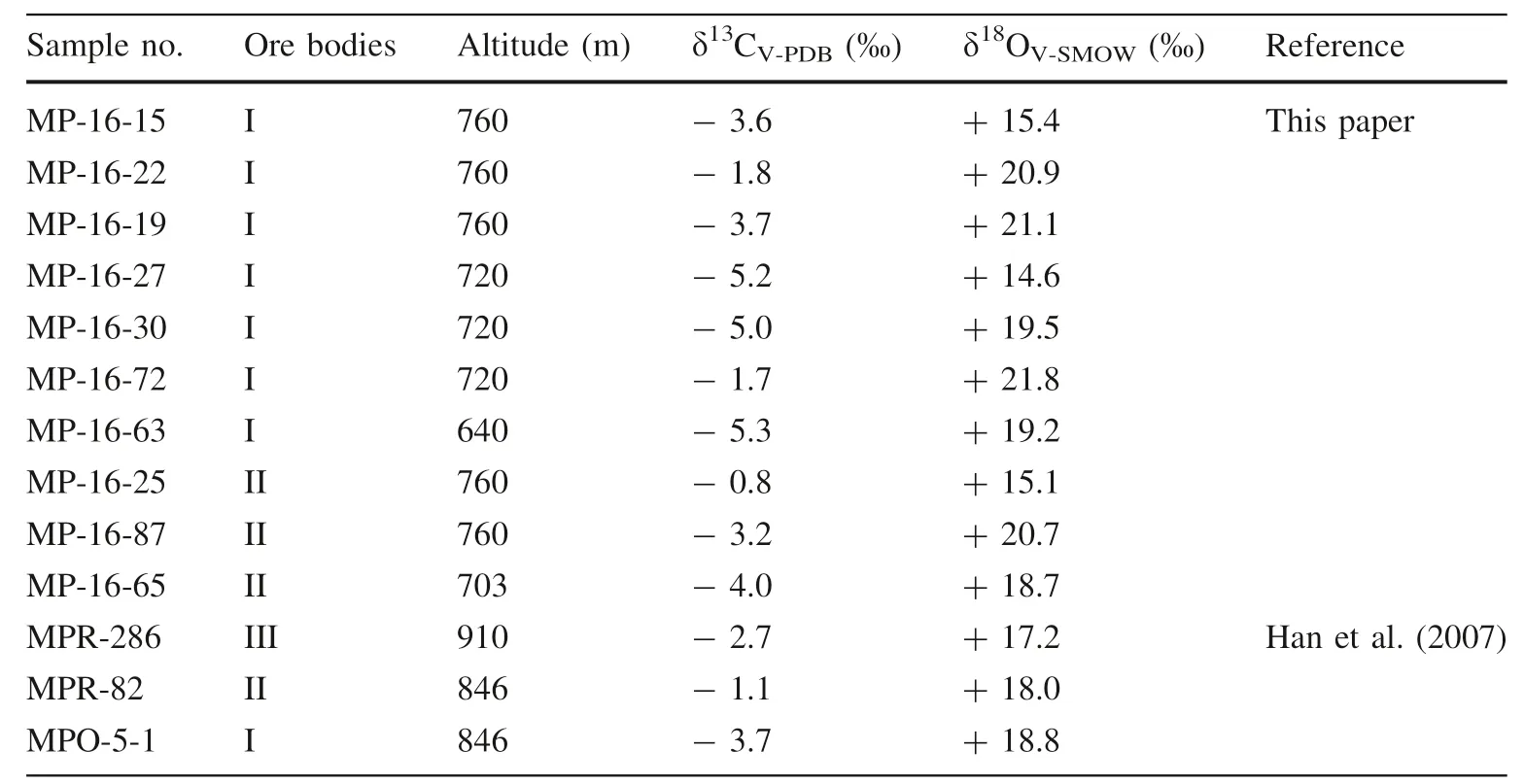
Table 1 Carbon-Oxygen isotopic compositions of calcite from the Maoping Pb-Zn deposit
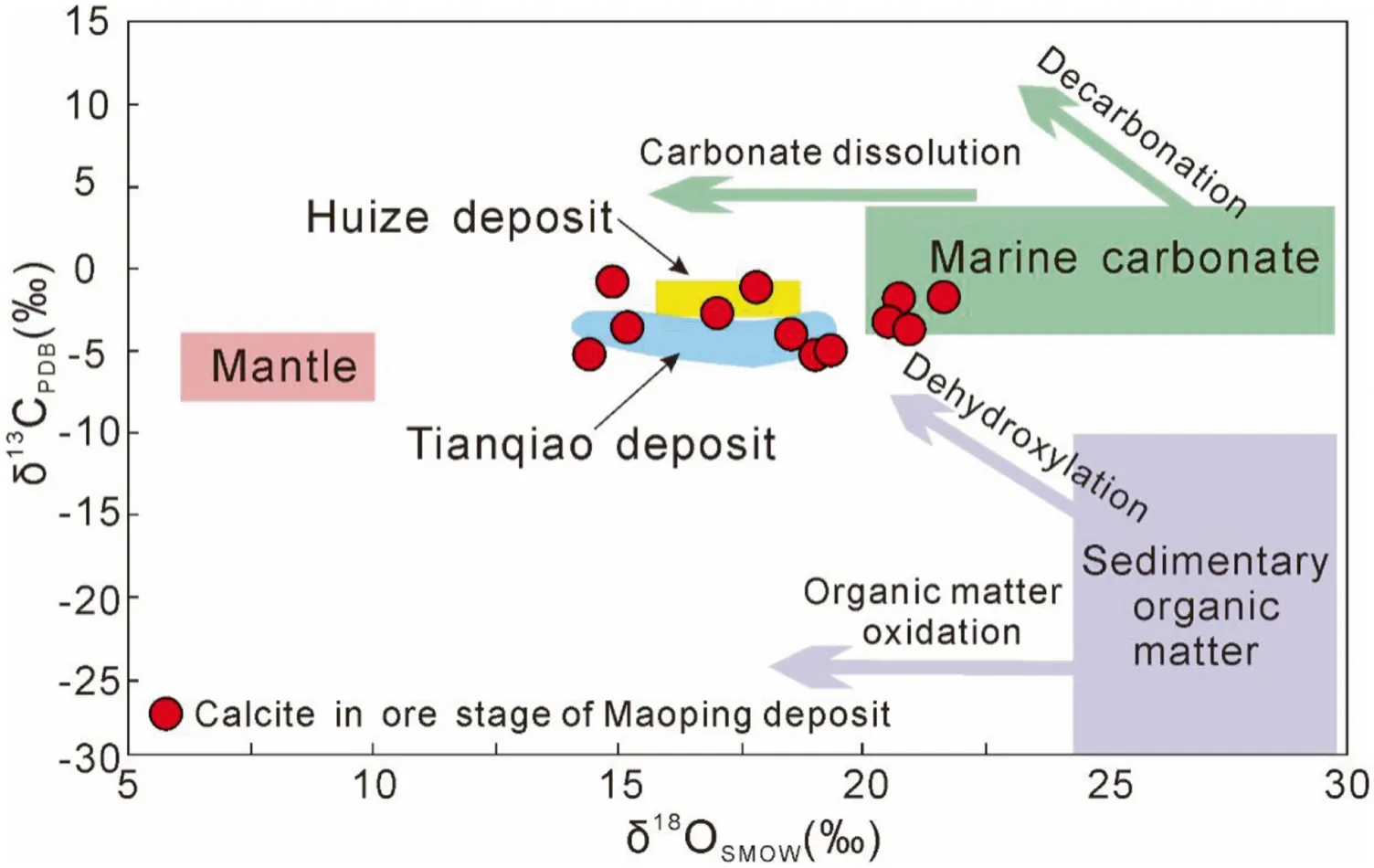
Fig. 5 Plots of δ13CPDB versus δ18OSMOW of ore-stage calcites in the Maoping deposit (the fields modified after Liu and Liu 1997). The data of Huize and Tianqiao Pb-Zn deposits are taken from Huang et al. (2010)and Zhou et al. (2013a),respectively
The systematic C-O isotopes in this study are similar but more scattered than previous δ13CPDB(- 3.7 to- 1.1 ‰) and δ18OSMOW(+ 17.2 to + 18.8 ‰) values(Table 1;Han et al.2007).The C-O isotopic compositions of calcites in the No. I orebody is consistent with those in the No. II and III orebodies (Table 1), indicating that the different orebodies share the same CO2origin in the Maoping deposit. Compared with the δ13CPDBand δ18-OSMOWvalues of the Huize (Huang et al. 2004, 2010) and Tianqiao (Zhou et al. 2012, 2013a) Pb-Zn deposit in the SYG region,the C-O isotopic data of the Maoping deposit plot in the similar field to the Huize and Tianqiao deposit(Fig. 5),which may suggest that regional ore-forming fluid have a homologous carbon and oxygen source. We thus consider that a mixture of ternary members that include the dissolution of marine carbonate rocks, the degassing process of the Emeishan mantle plume, and dehydroxylation of sedimentary organic matter could have collectively contributed CO2for ore-forming fluids, but the dissolution of marine carbonate rocks was the most significant CO2contributor.
5.2 Source of reduced sulfur
The total sulfur isotope composition (δ34SΣS) of oreforming fluids is essential for tracing sulfur source (Rye and Ohmoto 1974; Ohmoto 1972, 1979). Sulfur generally occurs in the form of sulfides rather than sulfate minerals under the condition of low oxygen fugacity(fo2)(Pinckney and Rafter 1972). Mineral assemblages mainly consist of sphalerite, galena, pyrite, dolostone, calcite, and quartz with the absence of sulfate minerals in the Maoping deposit, suggesting that δ34SCDTvalues of sulfides represent δ34SΣSof the ore-forming fluid (Ohmoto and Goldhaber 1997). Sulfur isotopic compositions of sulfides(sphalerite and galena) ranging from 13.1 to 21.8 ‰(n = 35, mean = 17.5 ± 3.0 ‰) are significantly different from mantle-derived sulfur (- 4 to + 8 ‰; Fig. 6;Chaussidon et al. 1989). Hence, basalts formed by the Emeishan mantle plume movement were unlikely to provide sulfur for hydrothermal fluids.
Sulfide samples collected systematically from the No.I-1 and I-2 orebody to constrain the sulfur source(s) of the Maoping deposit. Strikingly different δ34SCDTvalues(Table 2) occur among No. I-1 orebody (+ 13.1 to+ 19.0 ‰, n = 19, mean = + 15.2 ± 1.8 ‰), No. I-2 orebody (+ 18.03 to + 21.8 ‰, n = 16, mean = 20.2 ±1.4 ‰), No. II orebody (+ 8.6 to + 17.4 ‰, n = 8,mean = + 12.5 ± 3.1 ‰;Ren et al. 2018), and sulfides in unknown locations of the Maoping deposit (+ 22.5 to+ 25.7 ‰, n = 8, mean = + 24.1 ± 1.2 ‰; Tan et al.2019;Xiang et al.2020),which may be caused by different sulfur contributors. The δ34SCDTvalues of sphalerites(+ 13.1 to + 14.9 ‰) are lower than that of galena(+ 16.1 to + 19.0 ‰) from 720 to 810 m adits of No. I-1 orebody (Table 2; Fig. 6), indicating that the sulfur isotopic fractionation among sulfides did not reach an equilibrium. Conversely, sphalerites with δ34SCDTvalues of+ 20.1 to+ 21.8 ‰are higher than that of galena(+ 18.0 to + 19.0 ‰) from 720 to 810 m adits of No. I-2 orebody(Table 2; Fig. 6), suggesting an equilibrated S isotopic fractionation among sulfides. This sudden change of S isotopes between No. I-1 orebody over 720 m(δ34Ssphalerite< δ34Sgalena; Fig. 6) and No. I-2 orebody below 720 m (δ34Ssphalerite< δ34Sgalena; Fig. 6) demonstrate multiple sulfur reservoirs and complex metallogenic process in the Maoping deposit.
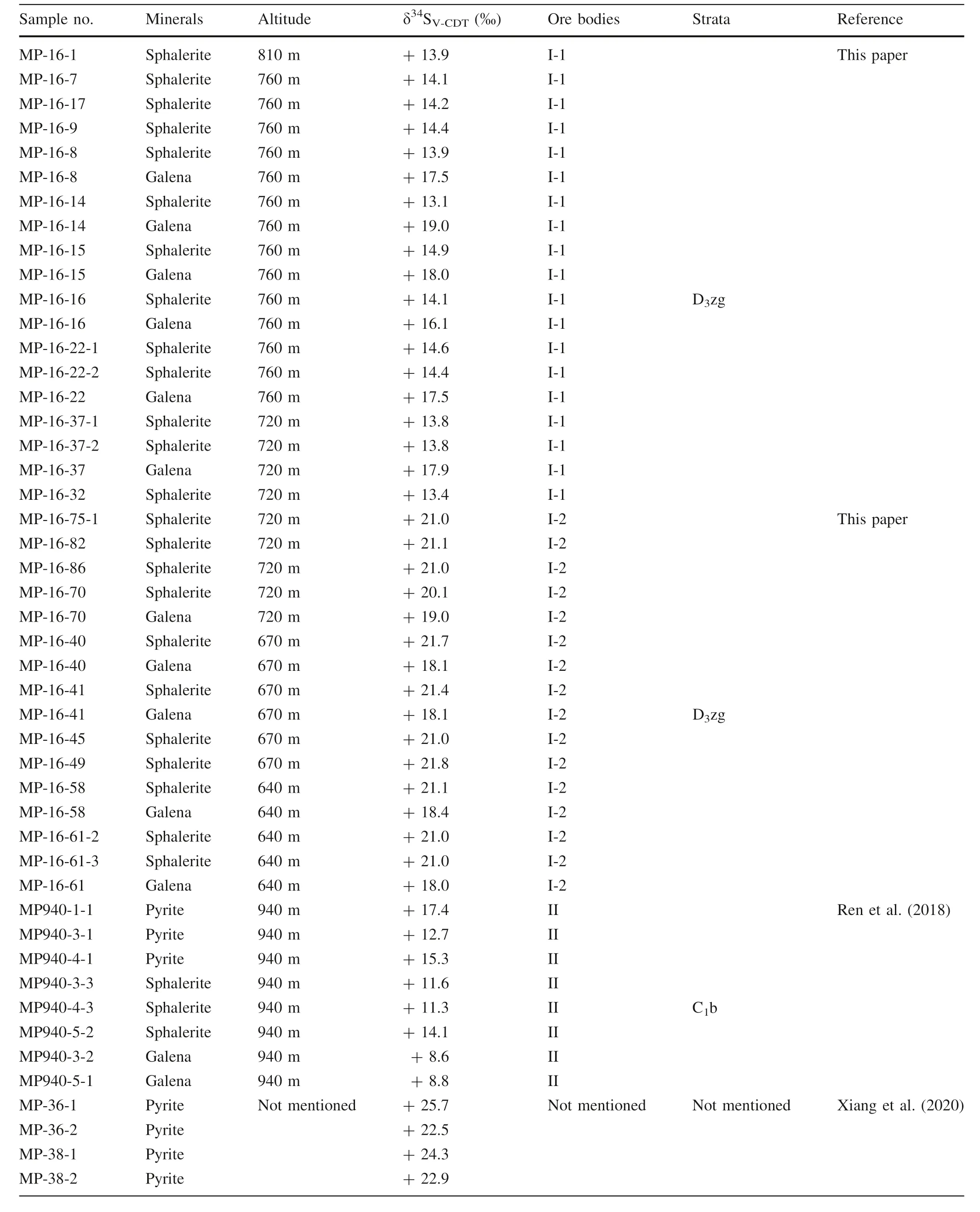
Table 2 Sulfur isotopic compositions of sulfides in the Maoping Pb-Zn deposit

Table 2 continued
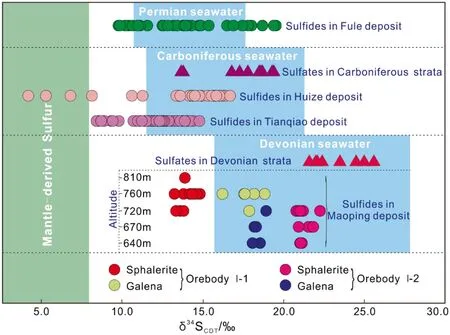
Fig. 6 Comparison of S isotopic compositions of sulfides, sulfates, mantlederived sulfur and seawater among the Pb-Zn deposits hosted in the different strata in the SYG metallogenic province.Sulfur isotopic data sources:Fule deposit (Zhou et al. 2018),Huize deposit (Li et al. 2007),Tianqiao deposit (Zhou et al.2014a), sulfates in the Carboniferous and Devonian strata (Ren et al. 2018),seawater in different ages(Claypool et al. 1980) and mantle-derived sulfur(Chaussidon et al. 1989)
Local sulfate reduction mechanism in the SYG Pb-Zn metallogenic province has been suggested by many researchers (Zhou et al. 2013a; Li et al. 2015; Ren et al.2018; Tan et al. 2019; Xiang et al. 2020). Previous studies proposed that the sulfur source(s)of the Pb-Zn deposits in the SYG region,such as Nayongzhi hosted in the Cambrian carbonate rocks, Huize hosted in the Carboniferous carbonate rocks and Fule hosted in the Permian carbonate rocks, were derived from evaporites in their ore-bearing strata (Huang et al. 2004; Zhou et al. 2013b, 2014b; Jin et al.2016;Wang et al.2017,Luo et al.2020).The reduced sulfur of No. II orebody (group) that hosted in the Lower Carboniferous Baizuo Formation has been proven to be derived from the thermochemical sulfate reduction (TSR)of the marine sulfates in the ore-bearing strata (Ren et al.2018), which was supported by suitable temperature(180-218 °C; Han et al. 2007; Liu et al. 2017), the existence of marine evaporites and reduced sulfur reservoir in the ore-hosting strata, implications from sulfur isotopic values of sulfides (+ 18.3 to + 22.7 ‰) and gypsums(+ 21.9 to+ 25.9 ‰).However,No.I-1 and I-2 orebodies with different sulfur isotopic compositions and fractionation mechanisms are both hosted in carbonate rocks of the Upper Devonian Zaige Formation. He sulfur isotopic values of No. I-1 orebody (+ 13.1 to + 19.0 ‰) and No. I-2 orebody (+ 18.0 to + 21.8 ‰) in Maoping are respectively consistent with those of Carboniferous marine sulfate minerals(gypsum and barite,+ 10.4 ‰ to+ 18.6 ‰;Ren et al.2018)and Devonian marine evaporites(gypsum,+ 21.9 to + 25.9 ‰; Ren et al. 2018) in the periphery ofore district (Fig. 6). Hence, we consider that the overlying Carboniferous sulfates leached by hydrothermal fluids were transported to ore-hosting strata, and then TSR took place under the action of organic matter to generate reduced sulfur reservoirs for No.I-1 orebody.The reduced sulfur of the No. I-2 orebody should come from the local TSR of evaporites in the Upper Devonian Zaige Formation.
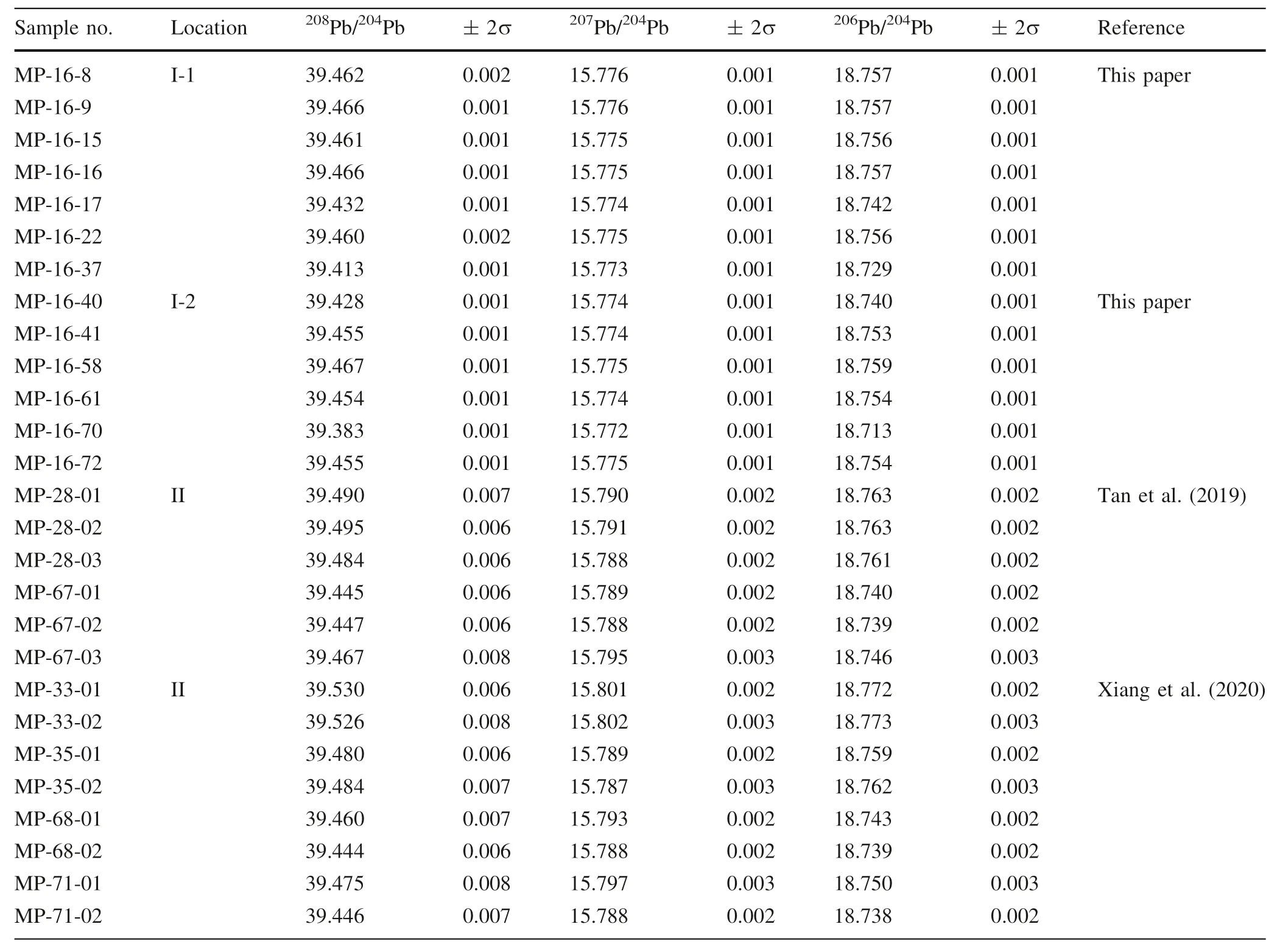
Table 3 Lead isotopic compositions of galena from the Maoping Pb-Zn deposit
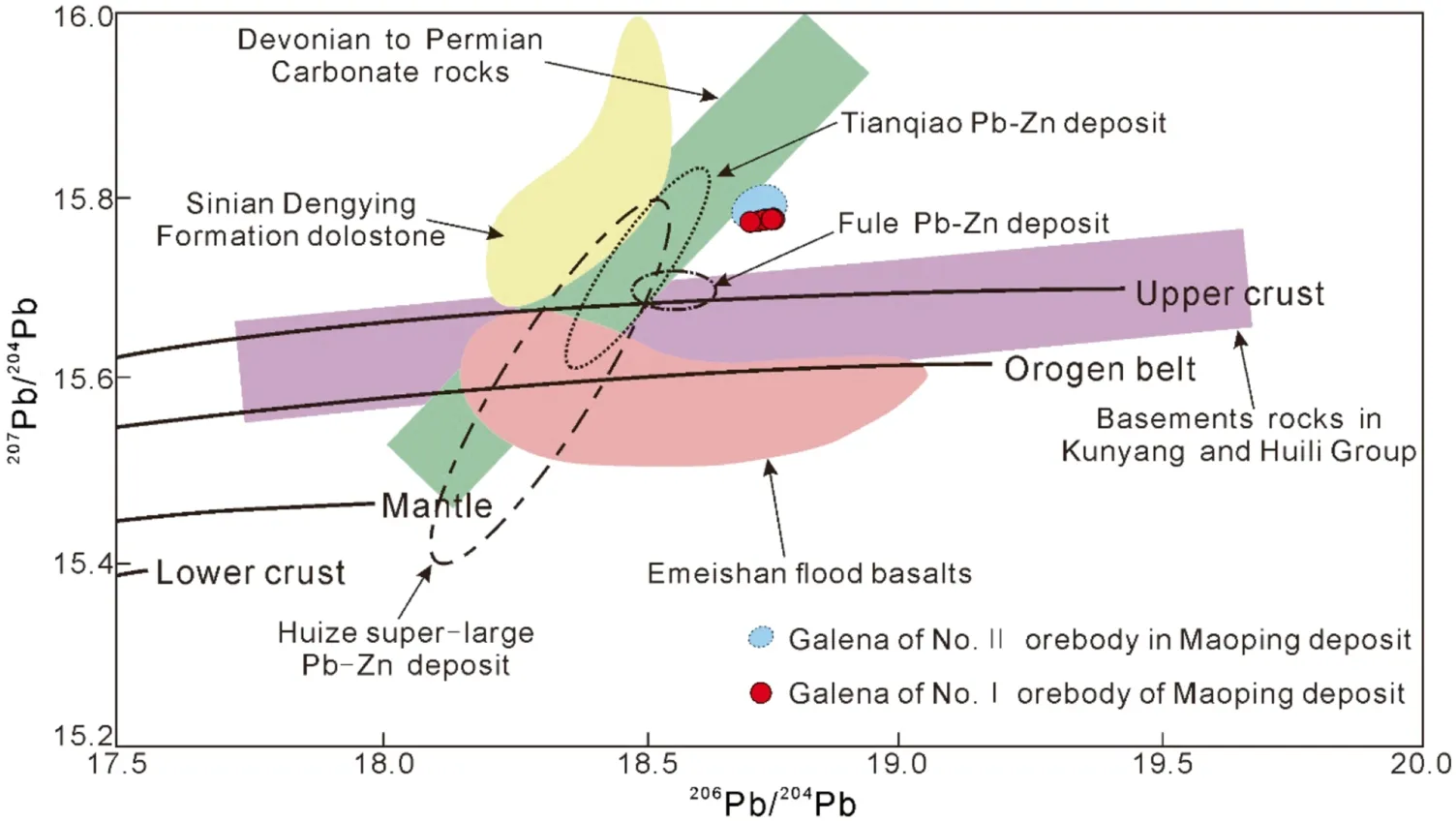
Fig. 7 Plots of 207Pb/204Pb versus 206Pb/204Pb of galena in the Maoping Pb-Zn deposit(fields modified after Zartman and Doe 1981). Pb isotopic compositions sources: Huize deposit (Huang et al. 2004),Tianqiao deposit (Zhou et al.2013a), galena of No. II orebody in the Maoping deposit(Tan et al. 2019; Xiang et al.2020), Devonian to Permian carbonate rocks, Sinian Dengying Formation dolostone,basement rocks in the Kunyang and Huili Group and Emeishan flood basalts(Huang et al.2004)
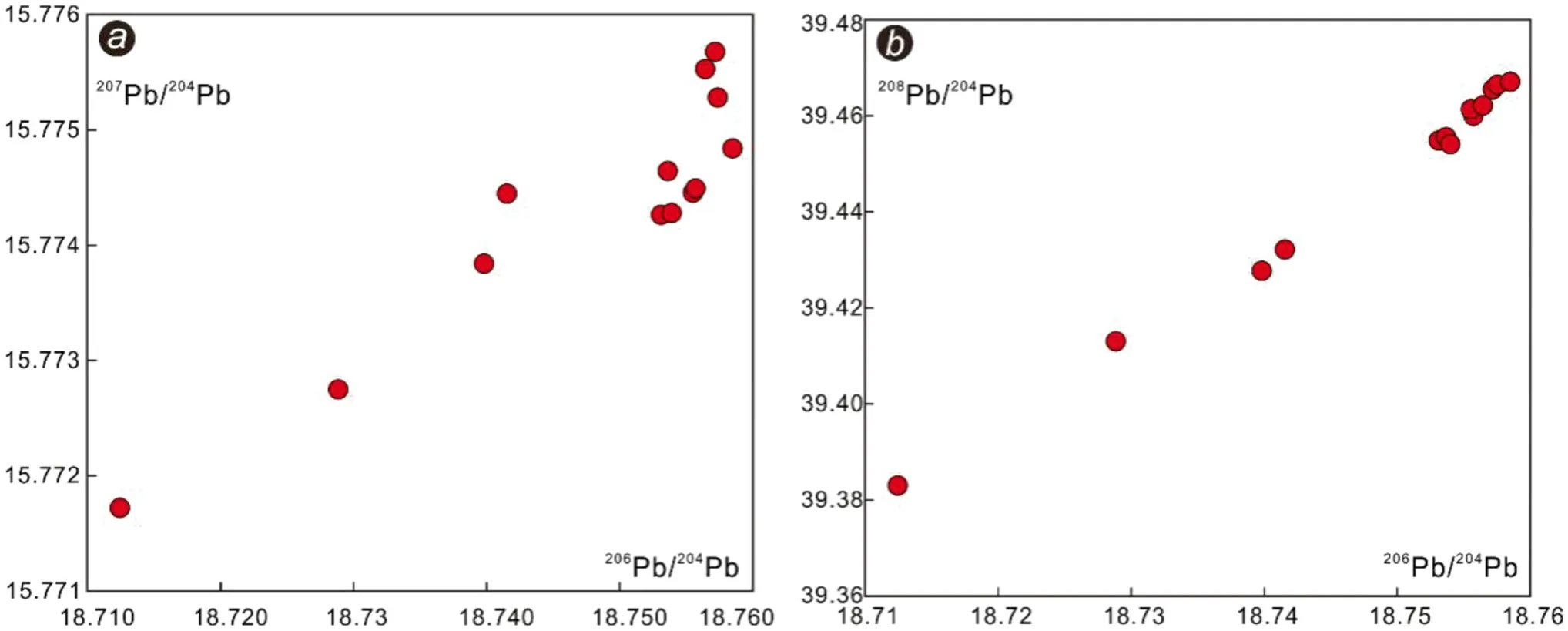
Fig. 8 Plots of 207Pb/204Pb versus 206Pb/204Pb (a) and 208Pb/204Pb versus 206Pb/204Pb (b) of galena in No. I orebody for the Maoping deposit
5.3 Source of metals
The Pb isotopic compositions of sulfides are considered approximately equal to that of ore-forming fluids owing to the contents of U and Th in those sulfides are too low to generate corresponding radiogenic Pb isotopes (Carr et al.1995;Zhou et al.2001;Gao et al.2020).The homogeneous Pb isotopic ratios with206Pb/204Pb of 18.713-18.759,207Pb/204Pb of 15.772-15.776, and208Pb/204Pb of 39.383-39.467 from No. I orebody analyzed by single galena grain are similar to those in situ Pb isotopic compositions (206Pb/204Pb = 18.738-18.773,207Pb/204Pb =15.787-15.802 and208Pb/204Pb = 39.444-39.530) from No.II orebody determined by MC-LA-ICPMS(Fig. 7;Tan et al. 2019; Xiang et al. 2020), suggesting that both the bulk and in situ analyses obtained accurate Pb isotopic data and all orebodies had an identical metal source in the Maoping deposit. This narrow and uniform Pb isotopic signature also indicates a single or well-mixed metal source(s) in the Maoping deposit.
Sinian to Middle Permian ore-hosting sedimentary rocks, Proterozoic Kunyang and Huili Group basements rocks and Late Permian Emeishan continental flood basalts are collectively regarded as three potential metal source rocks for Pb-Zn deposits in the SYG region (Liu and Lin 1999; Huang et al.2004; Zhou et al. 2018). Until now, the lack of accurate metallogenic age for the Maoping Pb-Zn deposit limits the understanding of the source and evolution of ore-forming fluids. Orebodies of the Maoping deposit hosted in the interlayer fracture zone of the Maomaoshan anticline in which the oldest strata are Permian(~ 250 Ma), which thus suggests that the Pb-Zn mineralization should be later than 250 Ma. Also, the main metallogenic age of 230-200 Ma was universally recognized for Pb-Zn deposits in the Upper Yangtze region (Li et al. 2007; Zhang et al. 2015; Hu et al. 2016, 2017b),whereas the Emeishan basalts were formed at 260 Ma ago(Zhou et al. 2002; Xu et al. 2004). Hence, it was hard for Emeishan basaltic rocks to contribute metals for Maoping deposit, which was also supported by Pb isotopic ratios plotting above the average upper crustal Pb evolution curves (Zartman and Doe, 1981) and remaining far away from that of the age-corrected(200 Ma;Xiang et al.2020)Emeishan basalts (Fig. 7).
In the diagram of207Pb/204Pb versus206Pb/204Pb(Fig. 7), the Pb isotopic ratios of galena in Maoping plot between those age-corrected (200 Ma, Xiang et al. 2020)basement metamorphic rocks and ore-bearing carbonate rocks but much closer to the latter,which indicate a mixed rather than single metal source for ore-forming fluids.Furthermore, all Pb isotopic ratios distributing in a steep linear trend (Fig. 8)also indicate that the metals may have been derived from a well-mixed source of different Pb endmembers (Carr et al. 1995; Ding et al. 2016). Thus, this study tends to suggest that the ore-forming metals for the Maoping deposit were mainly derived from the Devonian to Permian sedimentary rocks with a certain contribution from the Proterozoic Kunyang and Huili Group basement rocks.
5.4 Ore genesis
Controversies about the ore genesis of the Maoping deposit are mainly on epigenetic sedimentation-reworking(Liu and Lin 1999), strata-bound (Han et al. 2007; Hu 2004),hydrothermal reworking sedimentation-exhalative(SEDEX)(Wang et al.2009)and MVT(Zhang et al. 2005)Pb-Zn deposit. The characteristics of epigenetic hydrothermal mineralization in the Maoping deposit are strongly supported by the fault-fold ore-controlling system(Figs. 1,2,3),the occurrence of orebodies(Fig. 4a-c),ore fabrics(Fig. 4d-i)and isotopic features(Figs. 5,6,7).The multilayered Pb-Zn metallogenesis in carbonate rocks of the D3zg, C1b, and C2w indicates that the origin of the Maoping deposit is not a syn-sedimentary or SEDEX.
The Maoping deposit has many similar features with those typical MVT Pb-Zn deposit, such as the tectonic setting (carbonate platform), ore-hosting carbonate rocks(dolostone and limestone; Figs. 3, 4), common wall-rock alteration (dolomitization, calcitization, and silicification;Fig. 4), simple mineral assemblage (sphalerite, galena,pyrite, dolostone, calcite, and quartz; Fig. 4), fault-foldlithology ore-controlling factors(Figs. 2,3),marine sulfate as a sulfur contributor (Fig. 6), and metal sources from basements and sedimentary rocks (Fig. 7). However, differences also exist between the Maoping and typical MVT deposit as follow: (1) the Maoping deposit was spatially located in the ELIP (Fig. 1b; Huang et al. 2004; Li et al.2007), while the typical MVT deposit usually has little relationship with magmatism(Leach et al.2005,2010);(2)fluid inclusions features (180-218 °C, 4.1-9.5 wt% NaCl equiv.; Zhang et al. 2015; Liu et al. 2017) are different from those (50-250 °C, 10-30 wt% NaCl equiv.) of MVT(Leach et al.2005,2010);and(3)high grades(12-30 wt%Pb + Zn) of sulfide ores is inconsistent with that (av.Pb + Zn < 10 wt%) of the typical MVT Pb-Zn deposit(Leach et al.2005,2010).Zhang et al.(2019a,b)proposed that the high grades of sulfide ores in the SYG region was caused by relatively low pH of the ore-forming fluid(pH <3.6; Zhang et al. 2017), stronger driving forces to transport large-scale hydrothermal fluid (Han et al.2012, 2014), and a high degree of earlier formed hydroxides [Pb(OH)2and Zn(OH)2] converting into stable sulfides.Besides,the formation of a large amount of H2O was also associated with the conversion of hydroxides into sulfides, which was likely to dilute the ore-forming fluid resulting in a decrease in salinity. Hence, the similarities and differences between the Maoping and MVT Pb-Zn deposit indicate the particularity and complexity of the mineralization for Maoping deposit, which may be closely related to the local geological background, chemical conditions (pH, temperature, salinity), driving forces of transport, degree of hydrolysis, and redox conditions(Zhang et al. 2019a, b). But these particularities and complexities cannot deny that the genetic type of the Maoping deposit belongs to an MVT-like Pb-Zn deposit.
6 Conclusions
(1) The CO2in ore-forming fluids was generated by the dissolution of marine carbonate rocks, degassing process of the Emeishan mantle plume, and dehydroxylation of sedimentary organic matter.
(2) Like other Pb-Zn deposits in the SYG region, the reduced sulfur of the Maoping deposit was mainly produced by TSR of marine evaporites within the ore-bearing strata, but the reduced sulfur of the No.I-1 orebody hosted in the Upper Devonian Zaige Formation may have been contributed by marine sulfate in the overlying Carboniferous strata.
(3) The ore-forming fluid in the Maoping deposit has a mixed metal source involving the Devonian to Permian sedimentary rocks and the Proterozoic Kunyang and Huili Group basement rocks with the absent contribution of the Late Permian Emeishan basalts.
(4) The Maoping deposit is an MVT-like Pb-Zn deposit.
AcknowledgementsThis research project was supported by the National Natural Science Foundation of China(Grant Nos.U1812402 and 41673056). We would like to thank Engineer Jing Gu and Engineer Jing Hu for the assistance in isotopic analyses. We are also indebted to the Yiliang Chihong Mining Co.,Ltd for their permission to investigate and sample the Maoping deposit. We are grateful to Prof. Haifeng Fan and Prof. Yongyong Tang for the thoughtful comments. Their constructive and stimulating suggestions helped to significantly improve the manuscript.
杂志排行
Acta Geochimica的其它文章
- Late Ordovician mass extinction caused by global warming or cooling?
- In-situ LA-ICP-MS trace element and oxygen isotope signatures of magnetite from the Yamansu deposit, NW China, and their significance
- Geochemical constraints on the origin of Early Cretaceous alkaline intrusions and its tectonic implication, Sulu Orogenic Belt, Eastern North China Craton
- Hydrogeochemical characteristics of groundwater and quality assessment for the purposes of drinking and irrigation in Bougaa area, Northeastern Algeria
- Organic geochemical characteristics of Eocene crude oils from Zhanhua Depression, Bohai Bay Basin, China
- Geochronology and geochemistry of magmatic rocks in the Dongzi-Changhanboluo Pb-Zn ore district in Chifeng,Inner Mongolia, and their relationship with metallogenesis
